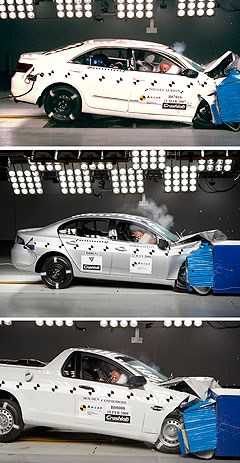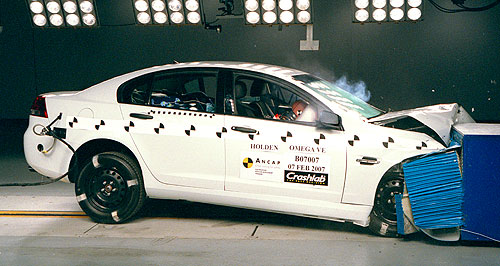Make / Model Search
News - Holden - CommodoreFive ANCAP stars for all Australian large sedansWallop: Holden's Commodore whacks the ANCAP barrier. Holden’s MY10 VE/WM series and Toyota’s Aurion achieve five-star safety rating28 Aug 2009 By TERRY MARTIN ALL Australian-built large sedans now have a maximum five-star crash-test rating under the Australasian New Car Assessment Program (ANCAP) after seatbelt reminders were added to the Toyota Aurion and the soon-to-be-released Model Year 10 Holden WM Statesman and Caprice and the full VE Commodore range. Driver and front passenger seatbelt reminders, and a manufacturer-funded optional pole test, are among the requirements for achieving a five-star rating from ANCAP – a result Ford achieved 12 months ago with its petrol-powered FG Falcon sedan, and extended to its E-Gas LPG sedan in April with the addition of electronic stability control (ESC), which is another prerequisite for five stars. With the latest move, Holden moves a step ahead of both Ford and Toyota because it is now the sole manufacturer with its entire Australian-built passenger-car range at the highest ANCAP level. Ford’s Territory SUV and previous-generation BF Mark III Falcon station wagon remains at the four-star mark, as does the Toyota Camry. Both ANCAP and Toyota Australia have advised that the results of the Aurion’s recent pole test, which demonstrates a vehicle’s crash performance in a side impact, will not be transferable to Camry. The latter also has only a driver’s seatbelt reminder. A Toyota spokesman said a significant investment would be required to add a front passenger seatbelt reminder to the Camry – more than what was needed for Aurion – and that, in any case, Australia’s biggest-selling brand would continue its policy of not using ANCAP results for marketing purposes. Holden fitted the seatbelt warning lights to the base Omega sedan and conducted a pole test in December 2008 in order to lift its ‘Commodore’ rating from four stars to five and stem the marketing advantage its archrival Ford Australia had with the five-star FG Falcon.  At the same time, the remainder of the WM/VE sedan range received significant modifications that improved its crash performance, such as a redesigned steering column shroud, which is designed to reduce driver knee injuries, and alterations to the rear doors that prevent them from coming unlatched in the event of a crash – as one did in the VE’s original ANCAP test. At the same time, the remainder of the WM/VE sedan range received significant modifications that improved its crash performance, such as a redesigned steering column shroud, which is designed to reduce driver knee injuries, and alterations to the rear doors that prevent them from coming unlatched in the event of a crash – as one did in the VE’s original ANCAP test.Holden has since gained five stars with the VE Sportwagon, but decided not to introduce the seatbelt reminders on the full VE sedan range and its WM long-wheelbase models to gain a series-wide five-star advantage until the MY10 upgrade, which is now entering production and will be launched during September. “We’ve always been very confident in these vehicles’ real-world safety capabilities, but even so it is rewarding to receive this third-party endorsement,” said GM Holden’s new chairman and managing director Alan Batey. “The five-star result reflects our rigorous approach to all aspects of vehicle safety. We are committed to a policy of continuous improvement which is highlighted with the launch of this exciting range.” Holden’s five-star rating applies to special-edition International sedans and all dual-fuel LPG Commodore sedans, but not the VE ute range, which is rated at four stars – despite the standard fitment of seatbelt reminders, side airbags and ESC. The Falcon-based FG ute is also rated at four stars, but could have obtained five had Ford Australia had funded a pole test. All VE sedan, wagon and WM models are fitted standard with six airbags, ESC, traction control, and ABS brakes with EBD and brake assist. As GoAuto has reported, critics of the NCAP regime argue that requirements such as the manufacturer-funded optional pole test and the inclusion of items such as a passenger seatbelt reminder warning light, which is unrelated to the vehicle’s crash performance, limit the effectiveness of the five-star rating. While welcoming the upgrade to the Australian-built models, ANCAP chairman Lauchlan McIntosh ANCAP chairman Lauchlan McIntosh emphasised the importance of ensuring that occupants were well harnessed. “When you look and see that we’ve now picked up all those Commodores, and the Statesman and the Caprice, and the Toyota Aurion, that’s a pretty big range of cars and means that all those large cars (including Falcon) are in the five-star bracket,” he said. “So it’s a good development when you think that it was not that long – a year ago – we weren’t there at all, with any of them. “Still, 35 per cent of people in South Australia who die in road crashes don’t have their seatbelts on, and I think it’s between 25 and 30 per cent nationally. We made a decision a long time ago to say that the seatbelt warning device was important in the rating, as was ESC. So when people want to start dissecting the score, that’s a bit of a nonsense. “All our (test) components are based on good, solid research and the seatbelt warning device is really important. It may well be a gadget that makes a buzz, but if we can save one or two lives because people actually took an effort to put their seatbelt on, it’s a great result. “For manufacturers not to put them in, which is not a massive shift in the way they’re made, I think it’s a fairly weak excuse. It’s like saying, ‘We don’t have a spare tyre, either.’ There’s all sorts of things you can leave out. We flagged this total package quite a long time ago – it’s not something that we’ve deliberately gone out to make it harder – and the seatbelt warning device is really very important.” Toyota Australia spokesman Mike Breen told GoAuto that a substantial amount of engineering work would be required to include a front passenger seatbelt warning device on the Camry. “It means a change in the wiring harness, which is quite expensive,” he said. “There’s the cost of doing that, plus the body structure doesn’t allow us to do that easily and cost-effectively. The structures within the Aurion bodyshell are different to Camry so it was easier for us to do it with Aurion than Camry.” Mr Breen said it costs several thousands of dollars for a pole test, in addition to a vehicle the manufacturer was also required to submit for testing. And he emphasised that, unlike Ford and other manufacturers, Toyota would not use a five-star result for marketing purposes. “We never have, and we don’t plan, to use NCAP results in any of our marketing, advertising or any other area,” he said. “Obviously, we recognise NCAP and the value that it is to the consumer. But … we are confident that the Camry meets all the requirements of safety because for a long time we have had a ‘global outstanding assessment’ where TMC (Toyota Motor Corporation) tests all its cars to meet all the requirements for all global markets. “We’re quite confident that Camry is every bit as safe as any other local model.” ANCAP representative and RACV chief engineer Michael Case told GoAuto at the time of the Omega’s five-star rating last December that the VE Commodore sedan could be considered as safe as the FG Falcon with the latest round of improvements, despite the fact that the FG sedan scored 34.61 out of 37 and the Commodore 33.45. A score of 32.5 or more is required for five stars. “In a broad sense it’s now as safe as the Falcon because it’s a five-star NCAP vehicle,” Mr Case said. “Technically, there’s still a slight difference in their score, and numerically the Falcon has a slightly higher score than the Commodore. But it’s hard to draw a conclusion that that means that one is really safer than the other.” ANCAP has also bestowed five-star ratings onto a handful of imported cars, using results and data from its affiliate Euro NCAP. Picking up the accolade is the Subaru Liberty and Outback, Alfa Romeo MiTo and Peugeot 308 CC.  Read more12th of May 2009  Holden cruises to five starsAll-new Holden small car gains maximum five-star ANCAP crash test rating4th of December 2008  Commodore now a five-star safety carANCAP elevates Commodore’s crash-test rating to a maximum five stars6th of August 2008  Five-star Falcon!New Ford Falcon becomes first Aussie-made car to score top five-star crash rating |
Click to shareHolden articlesCommodore pricing
Motor industry news |












Facebook Twitter Instagram